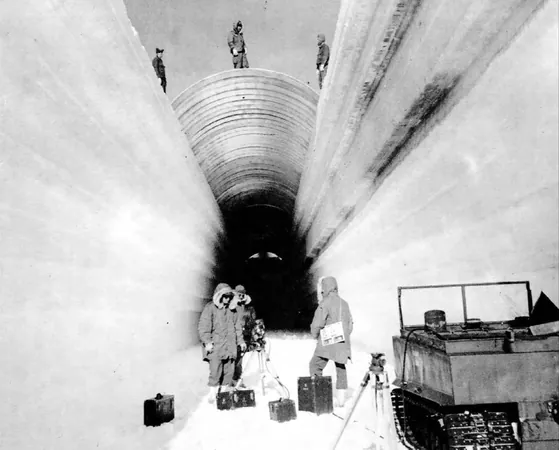
Shocking Discovery: NASA Finds Nuclear City Beneath Greenland's Ice! What Secrets Does Project Iceworm Hold?
2024-11-26
Author: Li
Introduction
In a jaw-dropping revelation, NASA has accidentally discovered a clandestine military installation hidden beneath the Greenland ice sheets, related to the U.S. military’s top-secret ‘Project Iceworm’ from the Cold War era, which was designed to house nuclear weapons.
NASA's Discovery
In April 2024, a dedicated team of NASA scientists, led by researcher Chad Greene, embarked on a mission to study the polar ice sheets of Greenland. Using advanced radar technology aboard a Gulfstream III aircraft, they were trying to assess the depth of the ice and the bedrock layers underneath. While conducting these routine observations, they stumbled upon a long-abandoned structure that turned out to be Camp Century, a U.S. military base established during the Cold War.
"We were primarily focused on the ice bed, and then suddenly, there it was: Camp Century," recalls Alex Gardner, a scientist at NASA’s Jet Propulsion Laboratory. The images captured provided valuable insights into the layout of the camp, which consists of a complex network of tunnels carved out of ice.
Historically, previous surveys had hinted at something beneath the surface, but they lacked the clarity to pinpoint the exact structures. Traditional ground-penetrating techniques offered only a two-dimensional view, making the camp resemble a mere distortion in the ice. However, this time, NASA utilized UAVSAR (Uninhabited Aerial Vehicle Synthetic Aperture Radar), which allowed for a more detailed three-dimensional mapping of the area.
The Hidden History of Project Iceworm
Launched in 1959, Project Iceworm aimed to establish an extensive network of mobile nuclear missile launch sites beneath the Greenland ice. The military’s strategy involved concealing up to 600 nuclear missiles in a system of tunnels stretching over 4,000 kilometers (approximately 2,500 miles). The rationale was simple: hide the missiles beneath Arctic ice to launch surprise strikes against the Soviet Union if needed.
Camp Century served as a small test site for this ambitious undertaking. Engineers worked tirelessly, excavating hundreds of feet beneath the ice to create living quarters, laboratories, and even recreational facilities for troops. This underground "city" included amenities like showers, a barbershop, and a library for around 200 military personnel.
While the project initially appeared promising, operational challenges became evident. The shifting ice posed significant risks, leading to the eventual abandonment of the camp by 1966. The ambitious Iceworm missile system never came to fruition, leaving behind a forgotten relic of Cold War paranoia.
The Environmental Legacy
With Camp Century now lost to history, a pressing concern looms over its abandoned site. Environmental experts warn that as the climate continues to warm, the ice sheltering Camp Century is likely to melt by 2090. This could potentially release buried contaminants—nuclear waste, fuel, and other hazardous materials—into the surrounding ecosystem, posing dire environmental hazards.
The U.S. government has acknowledged climate change implications and the risks posed by the remnants of Cold War military strategies. They pledge to collaborate with authorities in Denmark and Greenland to address the outstanding security and environmental questions regarding this historical site.
As scientists continue to unveil the mysteries beneath the ice, the discoveries at Camp Century underline the profound complexities of military operations and climate change—a narrative as relevant today as it was during the height of the Cold War.
Conclusion
NASA's findings not only serve as a harrowing reminder of the past but also as a vital resource for modern researchers to study the effects of climate change on glacier dynamics. The advanced technology used in this mission will likely lead to future breakthroughs in understanding both Arctic and Antarctic environments, unlocking even more secrets buried under the ice.
Stay tuned, as we delve deeper into the implications of this astonishing discovery! What other surprises does our planet hold beneath its frozen landscapes?



 Brasil (PT)
Brasil (PT)
 Canada (EN)
Canada (EN)
 Chile (ES)
Chile (ES)
 España (ES)
España (ES)
 France (FR)
France (FR)
 Hong Kong (EN)
Hong Kong (EN)
 Italia (IT)
Italia (IT)
 日本 (JA)
日本 (JA)
 Magyarország (HU)
Magyarország (HU)
 Norge (NO)
Norge (NO)
 Polska (PL)
Polska (PL)
 Schweiz (DE)
Schweiz (DE)
 Singapore (EN)
Singapore (EN)
 Sverige (SV)
Sverige (SV)
 Suomi (FI)
Suomi (FI)
 Türkiye (TR)
Türkiye (TR)